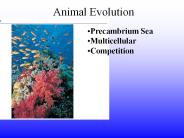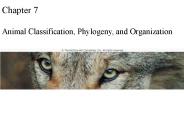Diploblastic PowerPoint PPT Presentations
All Time
Recommended
Some other diploblastic creatures Ctenophores Attributes of ctenophores Diploblastic Comb jellies--eight rows of ciliated plates Lack true nematocysts Active ...
| PowerPoint PPT presentation | free to download
General Body Plan Diploblastic epidermis gastrodermis Tissue Radially symmetrical Cnidocytes
| PowerPoint PPT presentation | free to download
General Body Plan Diploblastic epidermis gastrodermis Tissue Radially symmetrical Cnidocytes
| PowerPoint PPT presentation | free to download
patterns of organization 1. asymmetrical, radial, or bilateral 2. unicellular, diploblastic, or triploblastic 3. acoelomate, psuedocoelomate, or coelomate
| PowerPoint PPT presentation | free to download
... (polyp & medusa) Blind sack gut Radial symmetry Diploblastic Hydrostatic skeleton Nerve net Many colonial, some solitary forms polyps and medusa stage, ...
| PowerPoint PPT presentation | free to view
The Characteristics of Phylum Cnidaria Characteristics of Phylum Cnidaria radial symmetry blind sac gut (= coelenteron or gastrovascular cavity) diploblastic with ...
| PowerPoint PPT presentation | free to view
ectoderm. endoderm. mesoglea. Diploblastic (from the endoderm) (from the ectoderm) Triploblastic. Polyp and Medusa Body Forms. polyp. medusa. POLYP ANATOMY ...
| PowerPoint PPT presentation | free to download
Sexual Reproduction Meiosis function: production of gametes where: gonads of the mature adult; ovaries & testes. what: reduction & division result: haploid (1n) cells ...
| PowerPoint PPT presentation | free to view
Title: Chapter 32 Author: sean reagin Last modified by: administrator Created Date: 5/13/2002 10:56:18 PM Document presentation format: On-screen Show
| PowerPoint PPT presentation | free to download
Title: PowerPoint Presentation Last modified by: bferguson Created Date: 1/1/1601 12:00:00 AM Document presentation format: On-screen Show (4:3) Other titles
| PowerPoint PPT presentation | free to view
Chapter 33 Lower Invertebrates Animals 1 million species of animals 95% are invertebrates! 34-36 phyla of the Animal Kingdom 1. Phyla Calcarea & Silicea ...
| PowerPoint PPT presentation | free to view
Animal Evolution I. Animal traits A. Heterotrophic B. Mobile C. Lack cell walls D. Possess nerve and striated muscle D. Reproduces sexually 1.
| PowerPoint PPT presentation | free to view
Kingdom Animalia What s an Animal? Eukaryotic multicellular heterotrophs without cells walls. This includes a HUGE number of organisms you may not think of as ...
| PowerPoint PPT presentation | free to view
Phylum Cnidaria General Characteristics They are radially symmetrical; ... Ancylostoma ( Hook worm) Annilida : Annullus: little ring Triploblastic, ...
| PowerPoint PPT presentation | free to download
... a harpoon or nematocyst shoots out & injects poison into the prey Cnidocyte (stinging cell) Nematocyst (harpoon) Capturing Prey: Cnidocyte and Nematocyst at ...
| PowerPoint PPT presentation | free to view
Hydras - Jellyfish - Anemones - Corals. II. Animal Diversity. B. Radiata ... Hydra and jellies alternate between polyp and medusa stages; coral and anemones ...
| PowerPoint PPT presentation | free to view
EVOLUTION OF ANIMALS CHARACTERISTICS OF ANIMALS Multicellular Eukaryotic Heterotrophic (ingestion) No cell walls Nervous & muscle tissue Sexual reproduction Hox genes ...
| PowerPoint PPT presentation | free to view
... Phylum Bryozoa Phylum Annelida Phylum Arthropoda Phylum Mollusca Enterocoelous Phylum Echinodermata Phylum Chordata Coelom Development Endoderm ...
| PowerPoint PPT presentation | free to download
Tree of Life The tree of life according to Ernst Haeckel, 1891 How does Porifera fit in? How does Cnidaria fit in? Phylum Cnidaria Level of Organization Tissue Layers ...
| PowerPoint PPT presentation | free to download
Solid waste is excreted out the mouth Polyp General Anatomy ... Muscle, Skeletal ... (Planula larvae) in corals Class: Anthozoa (polyp only) Coral Sea ...
| PowerPoint PPT presentation | free to download
Can be monoecious or dioecious. Alternate generations ... Hydra. Freshwater. Polyps only, no medusae. Testes form sperm by meiosis. Ovaries form one egg each ...
| PowerPoint PPT presentation | free to download
Intro to Animal Diversity Chapter 32 Animalia General Notes 1.3 million species 300K plant species 1.5 million fungi 10 million bacteria Animals ARE heterotrophs ...
| PowerPoint PPT presentation | free to download
General Zoology Unit Two Have silicon based spicules Sometimes referred to as glass sponges All are deep sea forms Euplectella Some members are of the syconoid form ...
| PowerPoint PPT presentation | free to view
Kingdom Animalia - Diversity Metazoa Parazoa Eumetazoa Radiata Bilateria Where does Tricoplax adhaerens (Phylum Placozoa) belong? Older Phylogenetic Tree ...
| PowerPoint PPT presentation | free to download
... (Radiata): phyla Cnidaria Grade II (Bilateria): all other phyla Division A (Protostomia): Mouth is first opening Subdivision of Protostomes by coelom formation: ...
| PowerPoint PPT presentation | free to download
The Characteristics of Phylum Cnidaria Phylum Cnidaria Characteristics of Phylum Cnidaria radial symmetry blind sac gut (= coelenteron or gastrovascular cavity ...
| PowerPoint PPT presentation | free to view
The Animal Kingdom Classification and Organization Dr. Jim Whitfield
| PowerPoint PPT presentation | free to view
Animal Body Plans Major Body Plan Characteristics of Animals Symmetry Asymmetry Radial Symmetry Bilateral Symmetry Symmetry Radial Symmetry Pentamerous Radial ...
| PowerPoint PPT presentation | free to view
Nematocysts: More firearm than syringe? Study sequenced mediterrean jellyfish, Rhopilema nomadica venom. Identifed unique mechanical ...
| PowerPoint PPT presentation | free to download
An introduction to animal diversity BY Carlos Paez
| PowerPoint PPT presentation | free to download
Sponges and Placozoans Chapter 12 * Phylum Placozoa Trichoplax adhaerens is the sole species of phylum Placozoa (marine). No symmetry No muscular or nervous organs ...
| PowerPoint PPT presentation | free to download
Animal Diversity (32) Animal Development (47)
| PowerPoint PPT presentation | free to download
Klas Mammalia Hairy bodies, mammary glands, endothermic, pinnae Echinodermata Invertebrates in ecosystems Plant grazers Decomposition and recycling Invertebrata in ...
| PowerPoint PPT presentation | free to view
ANIMALIA Domain Eukarya, Kingdom Animalia Linnaeus classification: 2 Kingdoms (mid-1700s) Whittaker classification: 5 Kingdoms (1959) http://coralreefwatch.noaa.gov/ ...
| PowerPoint PPT presentation | free to download
... No two kinds of animals have the same binomial name Every animal has one correct name International Code of Zoological Nomenclature Genus ... microbes live in ...
| PowerPoint PPT presentation | free to download
e.g. flatworms, annelids, mollusks, arthropods. Deuterostomes ... Proboscis cavity. Nematoda. Organ System. Bilateral. No. Pseudocoelom. Annelida. Organ System ...
| PowerPoint PPT presentation | free to view
... fish is also protandry Finding Nemo is wrong! Dad should become Mom! Clown anemonefish & eggs with sea anemone The Other Anthozoan ...
| PowerPoint PPT presentation | free to download
... even though they don t have coeloms Nematoda Note that body cavity is not contained within mesoderm Note body cavity is contained within mesoderm A body ...
| PowerPoint PPT presentation | free to view
Zoology Presentation for university
| PowerPoint PPT presentation | free to download
BIOLOGY 1407 CHAPTER 32 and 33 INVERTEBRATES EMBRYOLOGY Colonial Choanoflagellate Ediacaran Fossils Neoproterozoic Era 1 Billion to 542 MYA Molecular Evidence Suggest ...
| PowerPoint PPT presentation | free to view
Corals. V. Kingdom Animalia. C. Major Phyla. 2. Cnidarians - Diversity - Body Plan ... alternate between polyp and medusa stages; coral and anemones have only polyps ...
| PowerPoint PPT presentation | free to view
9,000 species- mostly marine (150 fresh water) ... skeletal elements, transporting and storing food, forming contractile rings ...
| PowerPoint PPT presentation | free to view
... 3 3333f3 33 3 3 33 f3 3 3 ff3fff ff f3f33f3ff3 f3f3 ffff3fffff ffff ... 3 f 3 33 3f 3 3 3 f f3 ff f f f 3 f 3 f 3 f ...
| PowerPoint PPT presentation | free to view
Phylogeny of Extant Phyla Phylum Porifera Porifera Characteristics Choanocytes Amoebocytes Anatomy of Simple Sponge A More Complex Sponge Phylum Cnidaria Cnidaria ...
| PowerPoint PPT presentation | free to view
Opener Chapter 7 Chapter 7 Animal Classification, Phylogeny, and Organization Common names Crawdads, crayfish, or crawfish? English sparrow, barn sparrow, or a house ...
| PowerPoint PPT presentation | free to download
| PowerPoint PPT presentation | free to view
Filter food from water pumped through porous bodies nearly all are ... Any imaginary slice through the central axis would divide the animal into mirror ...
| PowerPoint PPT presentation | free to view
Lecture Exam I Cambrian radiation / phylogeny = 2 papers Systematics intro Protista: 10 phyla Animalia: Porifera, Cnidaria ~20 questions Short answer, essay, life ...
| PowerPoint PPT presentation | free to view
Principles of Development Chapter 8
| PowerPoint PPT presentation | free to download
May have algae or bacteria that give them color. Function much like choanoflagellates ... Undigested food leaves through osculum. Sponge Reproduction: ...
| PowerPoint PPT presentation | free to view
They have longitudinal muscles and so when the muscle contracts it creates a thrashing movement. ... Trichinella is a parasite of man pig and other mammals. ...
| PowerPoint PPT presentation | free to view
chapter 7 radiate animals cnidarians and ctenophores 7-*
| PowerPoint PPT presentation | free to download
Mostly sexual with flagellated sperm and nonmotile egg ... Spiral cleavage,Mouth develops form blastopore,mesoderm splits to form coelom ...
| PowerPoint PPT presentation | free to view
Intro to Animals & Development Beth Walker AP Biology Characteristics of Animals Multicellular Heterotrophic Eukaryotic Ingest their food Lack cell walls (cell ...
| PowerPoint PPT presentation | free to view
























































